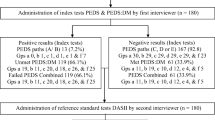Abstract
Objectives
To describe CDC Kerala experience of establishing an at-risk baby clinic and the comparison of different developmental screening tools at 12 mo against the gold standard Developmental Assessment Scale for Indian Infants (DASII).
Methods
At risk baby clinic of CDC, Kerala was established as a facility for follow up of NICU graduates from Sree Avittam Thirunal Hospital at 2, 4, 6, 8 and 12 mo corrected age and during each visit the mother is taught the CDC model early stimulation by developmental therapists and encouraged to continue to do the same at home. At 12 mo, assessment results of four simple developmental tools were compared with the gold standard DASII administered by a senior developmental therapist.
Results
Out of a total of 800 babies, outcome measurements at 12 mo were available for 604 infants. The prevalence of developmental delay using the screening tools, CDC grading for standing, Amiel Tison angles and DDST II (Denver II) gross motor were 24.8, 24 and 24.3 % respectively and using DASII, a diagnostic tool (13.3 %). Also the combination of Amiel Tison angles, CDC standing grading and DDST gross motor against DASII motor DQ had high specificity (94.15 %) and negative predictive value (NPV) (70.18 %) but with a very low sensitivity of 14.58 % and low positive predictive value (PPV) of 53.85 %. It was observed that a significant odds ratio for DASII mental deviation quotient (DQ) was seen for neonatal seizures (2.34) and low birth weight (1.49).
Conclusion
The prevalence of developmental delay using the screening tools, CDC grading for standing, Amiel Tison angles and DDST II (Denver II) gross motor were 24.8, 24 and 24.3 % respectively and together they had a high specificity, NPV and accuracy against DASII motor DQ as gold standard at one year assessment.
Similar content being viewed by others
References
Rydz D, Srour M, Oskoui M, Marget N, Shiller M, Birnbaum R, et al. Screening for developmental delay in the setting of a community pediatric clinic: a prospective assessment of parent-report questionnaires. Pediatrics. 2006;118:e1178.
Council on Children With Disabilities, Section on Developmental Behavioral Pediatrics, Bright Futures Steering Committee, Medical Home Initiatives for Children With Special Needs Project, Advisory Committee. Identifying infants and young children with developmental disorders in the medical home: an algorithm for developmental surveillance and screening. Pediatrics. 2006;118:405–20.
Squires J, Nickel RE, Eisert D. Early detection of developmental problems: strategies for monitoring young children in the practice setting. J Dev Behav Pediatr. 1996;17:420–7.
Nair MKC, Philip E, Jeyaseelan L, George B, Mathews S, Padma K. Effect of child development centre model early stimulation among at-risk babies–a randomized controlled trial. Indian Pediatr. 2009;46:S20–6.
Nair MKC, George B, Sabarinathan K, Bindu V, Praleema L, Philip E. Growth and development: CDC grading of motor milestones. Indian J Prac Pediatr. 1995; 3:53–4.
Amiel-Tison C, Grenier A. Neurological assessment during the first year of life. New York: Oxford University Press; 1986.
Frankenburg WK, Dodds J, Archer P, Shapiro H, Bresnick B. The Denver II: a major revision and restandardization of the Denver developmental screening test. Pediatrics. 1992;89:91–7.
Doll, Edgar A. The measurement of social competence: A manual for the Vineland Social Maturity Scale. US: Educational Test Bureau Educational Publishers; 1953. p. xvii 664.
Phatak B. Mental and motor growth of Indian babies (1–30 months). Final report. Baroda: Department of Child Development, MSUB; 1970. p. 1–185.
Narayan S, Aggarwal R, Upadhyay A, Deorari AK, Singh M, Paul VK. Survival and morbidity in extremely low birth weight (ELBW) infants. Indian Pediatr. 2003;40:130–5.
Costello D, Friedman H, Minich N, Siner B, Taylor G, Schuchlter M, et al. Improved neurodevelopmental outcomes for extremely low birth weight infants in 2000–2002. Pediatrics. 2007;119:37–45.
Escobar G, Littenberg B. Petitti DB Outcome among surviving very low birth weight infants: a meta analysis. Arch Dis Child. 1991;66:204–11.
Acknowledgments
The authors gratefully acknowledge the cooperation and support received from staff of Child Development Centre, Kerala, specially Dr. G. Suresh Kumar, Registrar; Ms. Deepa N. R, PS to Director; Mr. Asokan N, PA to Director; Ms. Suja S, Junior Programmer; CDC, Medical College, Thiruvananthapuram, in conduction of this study.
Conflict of Interest
None.
Source of Funding
This study is supported by Child Development Centre, Thiruvananthapuram.
Author information
Authors and Affiliations
Corresponding author
Rights and permissions
About this article
Cite this article
Nair, M.K.C., Krishnan, R., Harikumaran Nair, G.S. et al. CDC Kerala 3: At-risk Baby Clinic Service Using Different Screening Tools – Outcome at 12 months Using Developmental Assessment Scale for Indian Infants. Indian J Pediatr 81 (Suppl 2), 80–84 (2014). https://doi.org/10.1007/s12098-014-1526-0
Received:
Accepted:
Published:
Issue Date:
DOI: https://doi.org/10.1007/s12098-014-1526-0



